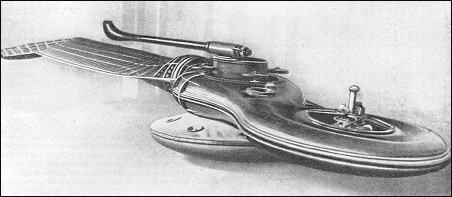|
Papin and Rouilly's "Gyropter" possessed only a single hollow blade with a plan area of 12 square metres. The counterweight was a fan worked from a Le Rhone 80hp rotary engine revolving at 1.200 r.p.m. to give an output of just over 7 cubic metres of air per second. At the centre of gravity between the blade and the fan was the pilot's cab. The fan drove air through the hollow blade, from which it escaped through an L-shaped tube at a speed of 100 metres per second.
Including the float on which it was mounted the aircraft weighed 500kg. Directional control was to be achieved by means of a small auxiliary pipe through which some of the air was driven, and which could be directed in whatever direction the pilot wished.
Tests were carried out on 31st March 1915 on Lake Cercey on the Cote d'Or, and a rotor speed of 47 r.p.m. was reached. Unfortunately the aircraft became unstable and the pilot had to abandon it, after which it sank. P.Lambermont "Helicopters and Autogyros of the World", 1958
Warning: mysqli_connect(): php_network_getaddresses: getaddrinfo for mysql5.zone.ee failed: Name or service not known in /data03/virt15346/domeenid/www.aviastar.org/htdocs/helicopters_eng/papin.php on line 62
Fatal error: Uncaught mysqli_sql_exception: php_network_getaddresses: getaddrinfo for mysql5.zone.ee failed: Name or service not known in /data03/virt15346/domeenid/www.aviastar.org/htdocs/helicopters_eng/papin.php:62
Stack trace:
#0 /data03/virt15346/domeenid/www.aviastar.org/htdocs/helicopters_eng/papin.php(62): mysqli_connect('mysql5.zone.ee', 'd14657sa18989', Object(SensitiveParameterValue))
#1 {main}
thrown in /data03/virt15346/domeenid/www.aviastar.org/htdocs/helicopters_eng/papin.php on line 62
| 




